To Die For Blu-ray Movie
HomeTo Die For Blu-ray Movie 
Image Entertainment | 1995 | 106 min | Rated R | Nov 08, 2011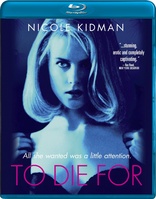
Movie rating
7.2 | / 10 |
Blu-ray rating
| Users | 4.0 | |
| Reviewer | 3.5 | |
| Overall | 3.5 |
Overview
To Die For (1995)
Suzanne Stone wants to be on television and she is willing to do whatever it takes to get what she wants. As she pursues her goal with relentless focus, she refuses to let anything or anyone stand in her way.
Starring: Nicole Kidman, Joaquin Phoenix, Matt Dillon, Illeana Douglas, Dan HedayaDirector: Gus Van Sant
| Drama | Uncertain |
| Dark humor | Uncertain |
| Crime | Uncertain |
| Comedy | Uncertain |
Specifications
Video
Video codec: MPEG-4 AVC
Video resolution: 1080p
Aspect ratio: 1.85:1
Original aspect ratio: 1.85:1
Audio
English: LPCM 2.0
Case is incorrect
Subtitles
English SDH, Spanish
Discs
25GB Blu-ray Disc
Single disc (1 BD)
Playback
Region A (C untested)
Review
Rating summary
| Movie | 4.5 | |
| Video | 3.5 | |
| Audio | 2.5 | |
| Extras | 0.5 | |
| Overall | 3.5 |
To Die For Blu-ray Movie Review
Video Drone
Reviewed by Michael Reuben October 28, 2011Before getting her first Oscar nomination for Moulin Rouge!, winning the following year for The Hours and becoming the movie star she is today, Nicole Kidman played second fiddle to plenty of men. The most famous example, of course, was former husband Tom Cruise, with whom she co-starred in Days of Thunder (1991), Far and Away (1992) and Eyes Wide Shut (1999), but there were others, including Val Kilmer in Batman Forever (1995) and George Clooney in The Peacemaker (1997). As for that rara avis, the female lead, she had to take other actresses' leavings. In 1994, she talked Gus Van Sant into casting her as Suzanne Stone Maretto, the anti-heroine of To Die For, after Meg Ryan walked from the picture. Playing a character who is described by her sister-in-law as "a four-letter word, begins with a 'c'" (it's not what you think), Kidman got people to sit up and take notice by giving what remains one of her best and most unhinged performances as a dingbat media whore who will do anything -- literally, anything -- to be famous on television. Buck Henry, co-creator of Get Smart and one of the screenwriters of The Graduate, wrote the acidly satirical script from a novel by Joyce Maynard, who has a cameo in the film. Maynard based her book on a contemporary crime in which a woman seduced a teen into killing her husband, but she and Henry kept their focus on a much larger cultural phenomenon. The allure of easy fame and the extreme behavior it inspires had already begun to change American culture, long before the internet and YouTube; Martin Scorsese's The King of Comedy (1983) looked at the subject with such unsparing frankness that many viewers still find the film hard to watch. But with Van Sant's light touch and Kidman's droll comic delivery, To Die For hits the precise satiric note to elicit laughter (or at least chuckles), even though we're told from the outset that a perfectly nice guy is lying dead in a pool of blood and a couple of teens have had their lives ruined.
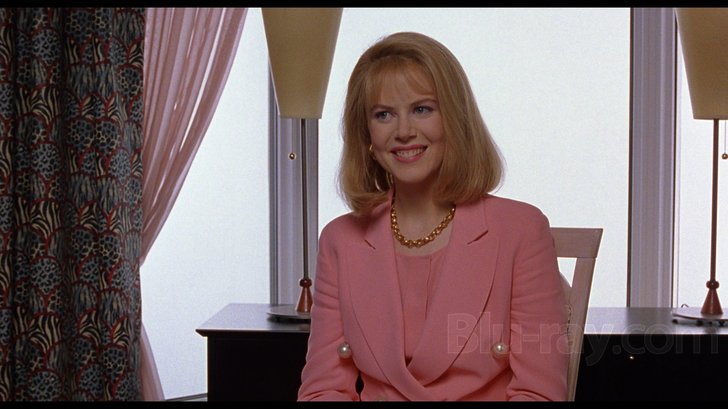
As befits a story about someone who wants to be on TV, To Die For unfolds as a series of interviews and flashbacks (I almost said "reenactments"). Some of the interviews are chatty and personal, like a gossip show; some are focused and intense, like a news show (which is really just a "serious" take on the latest gossip); and one odious, but dramatically useful, discussion occurs on one of those daytime gawk-fests where the producers gather the most volatile group possible in the hope of igniting a conflagration -- in this case, the four parents of the couple whose marriage resulted in the husband's murder and the wife's arrest. The delighted center of this media frenzy is Suzanne Maretto (Kidman) -- or Suzanne Stone, her professional name, as she likes to stress -- whose entire philosophy of life can be summed in the phrase that you're nobody in America unless you're on TV. Since her aptly named home town of Little Hope, New Hampshire doesn't offer much opportunity, she targets an eligible bachelor, Larry Maretto (Matt Dillon), a popular and handsome jock who could have had any girl in town, as his devoted sister Janice (Illeana Douglas) assures her interviewer. Larry's family (who, as everyone including Suzanne is quick to affirm, have nothing to do with the mafia) owns a successful restaurant, which gives Larry the means to support Suzanne. That's presumably why she married him, because love doesn't enter into it. Suzanne arranges their Florida honeymoon to coincide with a convention of news broadcasters. While Larry spends his days deep-sea fishing, Suzanne trawls the convention for contacts and tips. She gets both (and maybe more) from a salty convention attendee played by George Segal in a memorable uncredited appearance. Back home, Suzanne disappoints her new in-laws, Joe and Angela Maretto (Dan Hedaya and Maria Tucci), as well as her parents, Earl and Carol (Kurtwood Smith and Holland Taylor), by making it clear she has no interest in providing them with grandchildren. Instead, she wangles a job as a go-for at the local TV station, where the manager, Ed Grant (Wayne Knight), nicknames her "Gangbusters", because she comes on like . . . you know. Eventually, Suzanne prevails on Grant to let her do the weather. As far as Suzanne is concerned, she's two steps away from a major network. One small problem, though: Larry Maretto, who isn't the brightest guy around, never realized he was marrying a career woman, and he doesn't like where their life is headed. So, as an old crime boss might say, he has to go. Suzanne has been working on a "documentary" about teenage life, using students from the local high school. (Screenwriter Buck Henry plays their teacher, Mr. Finlaysson.) One student, Jimmy (Joaquin Phoenix), has a mad crush on Suzanne, and she encourages it by spending extra time with Jimmy and his two friends, Lydia (Alison Folland) and Russell (Casey Affleck, in his first film). Sensing the weak spot in each of them -- Russell wants to think of himself as a bad ass, Lydia is desperate for a friend, and Jimmy is a hormonally hopeless romantic -- Suzanne gets them to murder Larry while she's doing the weather, leaving her with a perfect alibi. For an extra dollop of sentiment (or irony), she arranges it for their first wedding anniversary. Of course, the teens make countless mistakes, and two local cops (Michael Rispoli and Tim Hopper) quickly divine Suzanne's role. But she's insulated herself effectively, and her arrest only gives her more of what she craves: notoriety. The scene in which Suzanne is being led out of the courthouse is one of Van Sant's best, because it so effectively juxtaposes subjective and objective points of view. Photographers and journalists are crowding about, and the sound of questions being yelled out has to compete with shutters snapping and flashes popping. But to Suzanne it all sounds like applause. She's made it. She's famous. Still, like any ruthless climber, Suzanne has left plenty of wreckage in her wake, and not just Larry Maretto's body and his grieving family. The film's most affecting scenes are the interviews with Jimmy in prison, where he'll spend the rest of his life dreaming of a gorgeous creature that appeared to him briefly, like some goddess out of Greek mythology, then vanished for good. Except for the prison bars, he might think he'd imagined it all. Joaquin Phoenix is so convincingly lost in these scenes that, at the time, before he'd demonstrated the full range of which he was capable, he seemed like some street kid Van Sant had found for the part. The film's conclusion features a guest appearance by director David Cronenberg, who plays someone to whom Suzanne wants to sell the rights to her life story for development as a Hollywood project. The ending is part fairy tale, part sick joke, but it does feature one of my favorite last shots, not the least because we come back to Janice Maretto, who has spent the better part of the film in Suzanne's shadow. In her own modest way, Janice too has show business aspirations: as a figure skater. Her announcement to the family of her first professional job got preempted by Suzanne, but she gets to finish the film on the ice. She isn't much of a skater, but it's where she's skating that counts.
To Die For Blu-ray Movie, Video Quality 
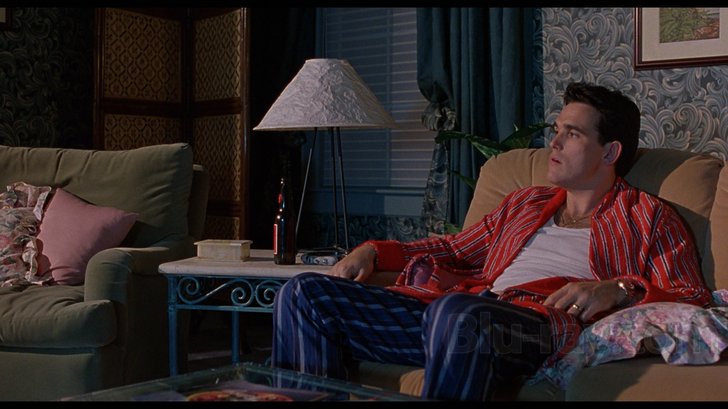
To Die For is one of the catalogue titles that Sony has licensed to Image Entertainment, and Image has produced a respectable 1080p, AVC-encoded Blu-ray that effectively represents Gus Van Sant's typically low-key imagery. (The cinematographer was Eric Alan Edwards, who shot several features for Van Sant in the Nineties, as well as films for Larry Clarke, before moving on more recently to studio comedies like Knocked Up and The Change-Up.) Even when he's doing a period piece like Milk, Van Sant has never tried to draw attention to the photography in his films, which is an intriguingly "old school" quality in a director long considered counter-cultural. Still, television is the subject of To Die For; so, just as Sidney Lumet instructed his cinematographer in Network to "corrupt the camera" by gradually making the lighting more artificial, Van Zant has Edwards light many of the interior scenes with an extra dose of pizzazz. This helps them blend more easily with the TV interview footage, and it also establishes a marked contrast with the wintry New Hampshire (actually Ontario) outdoors, which reflects the dull reality Suzanne wants to escape. I've sometimes been accused of "making excuses" for a disc when I say it doesn't "pop", but that's really just my way of telling the demo disc crowd that this isn't their kind of Blu-ray -- or movie. I rate this transfer highly, because it accurately reproduces the film's look without any obvious effort to freshen, update or "improve" it to resemble a contemporary digital production, a big-budget Technicolor extravaganza, or any other style of filmmaking that some viewers might find preferable. The Blu-ray's image has subtle, excellent detail on clothing and other fine textures, which is especially important for Suzanne's array of tasteless but attention-grabbing outfits. Everything in Suzanne's life has been borrowed from a glossy magazine, and the better you can see that, the better you understand Suzanne. Black levels are very good, and the film's grain patterns are stable and natural-looking. Fine detail suffers on just a few occasions from minor aliasing noise, and a shot of Lydia near the end appears to have an unstable background, but since the problem is limited to that one shot, it's presumably a flaw in the original element. The final shot of Jimmy in the prison interview room exhibits some minor edge ringing, which would be a concern if it were pervasive throughout the transfer, but it isn't. These issues aside, I saw no signs of high-frequency filtering, transfer-induced ringing or other inappropriate digital tampering, nor did I spot any compression artifacts.
To Die For Blu-ray Movie, Audio Quality 
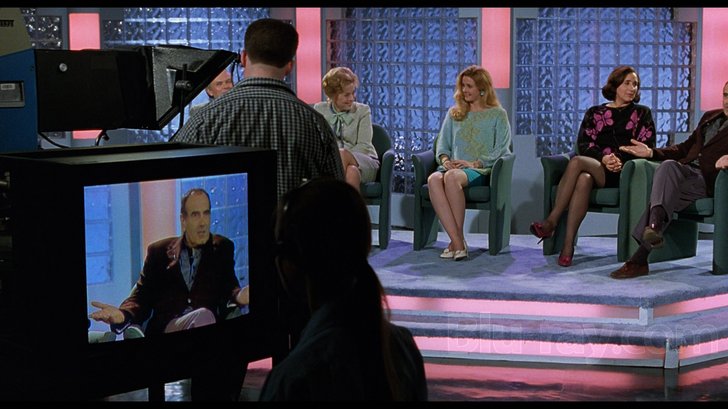
On the audio front, the news is somewhat perplexing. Anyone following Disney's catalogue releases through Mill Creek is familiar with the disappointment of having films released to theaters with a 5.1 soundtrack issued on Blu-ray with only stereo surround. But Image and Sony have been very reliable about supplying original audio mixes -- until now. To Die For was released in 1995, two years after discrete multi-channel formats appeared in theaters, and its credits feature the "SDDS" logo for Sony's multi-channel format at a time when Sony owned the Loews theater chain and was making a much greater effort than now to promote that proprietary format for delivering digital sound in theaters. But, more tellingly, when Sony released To Die For in 1998 on the still-new DVD format, the DVD had a 5.1 soundtrack in Dolby Digital. Why wasn't that soundtrack provided to Image? What we get on the Blu-ray is a PCM 2.0 surround track (and not, as the back of the case indicates, a DTS-HD MA 2.0 track). Now, don't get me wrong: It's a fine-sounding track. Voices are clear, sound effects are fully rendered, there's a decent sense of ambiance from the surround decoder, and the score by Danny Elfman (the ideal composer for a satire of this nature) sounds musical and lively. A 2.0 track was also included on the DVD, as was standard for Sony in the format's early days, and one can reasonably assume, given the slow rollout of new hardware that is typical of penurious theater owners, that many patrons in 1995 never heard the 5.1 mix, because their local theaters hadn't yet invested in the new decoders. Still, that was sixteen years ago. Today, even a low-end receiver can decode DD and DTS. Why couldn't Sony just dig up that 5.1 mix for To Die For from the vault and ship it to Image? If Sony couldn't find it, why not just rip the 5.1 off the DVD (which would be better than nothing)?
To Die For Blu-ray Movie, Special Features and Extras 
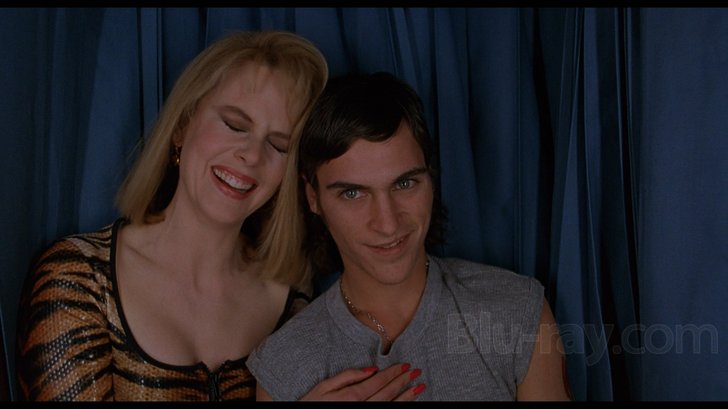
Nothing has been omitted from Sony's 1998 DVD, which was almost featureless.
- Theatrical Trailer (HD; 1.85:1, 2:18): The trailer made inspired use of Don Henley's "Dirty Laundry", which wouldn't have fit with the tone of the film itself, but was perfect for a promotional spot.
To Die For Blu-ray Movie, Overall Score and Recommendation 
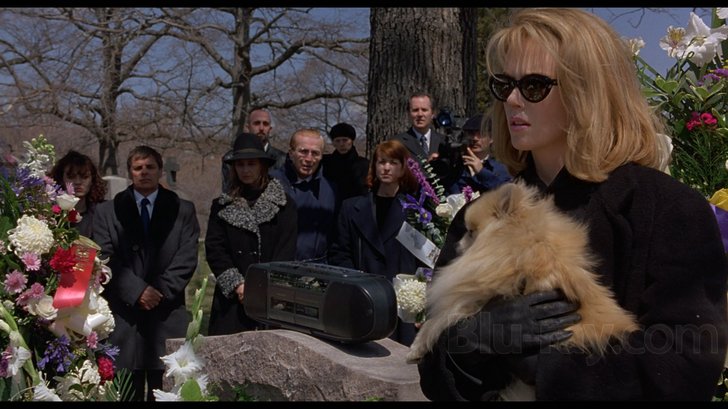
Just as Network proved prophetic about the future of television, To Die For accurately predicted the future direction of fame culture. There was just one wrinkle, and it's summed up by Lydia near the film's end:
Suzanne used to say that you're not really anybody in America unless you're on TV. . . 'cause what's the point of doing anything worthwhile if there's nobody watching? So when people are watching, it makes you a better person. So if everybody was on TV all the time, everybody would be better people. But, if everybody was on TV all the time, there wouldn't be anybody left to watch, and that's where I get confused.With the internet, digital technology and handhelds, we've solved that. We've provided access to millions of potential Suzannes, dramatically expanded the possibilities for being watched, and allowed everyone the option to be either on, or watching, TV -- all the time. I don't think that's made anyone a better person, but you be the judge. As a movie, To Die For is highly recommended. I give the Blu-ray a qualified recommendation because of the soundtrack issue; it won't impair your enjoyment of the film, but Image (and Sony) shouldn't get a pass on such an obvious gaffe.
Similar titles
Similar titles you might also like

Mean Streets 4K
1973

The King of Comedy
1982

Birdman
Birdman or (The Unexpected Virtue of Ignorance)
2014

Hi, Mom!
1970

Carnage
2011

The Sopranos: The Complete Series
1999-2007

Monsieur Verdoux
1947

Network
1976

Spring Breakers
2012

Little Caesar
1931

Happiness 4K
1998

And Justice for All
...And Justice for All
1979

If....
1968

Election 4K
Paramount Presents #46
1999

Modern Times
1936

The Miami Story
1954

Mistress America
2015

Little Miss Sunshine
2006

The Fisher King 4K
1991

The Narrows
2008

